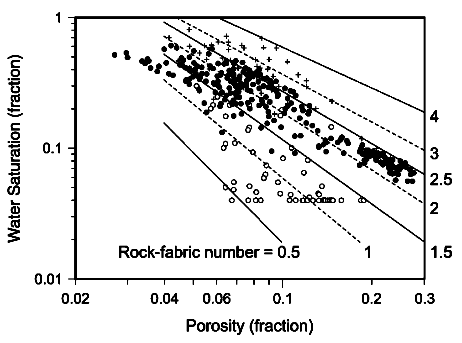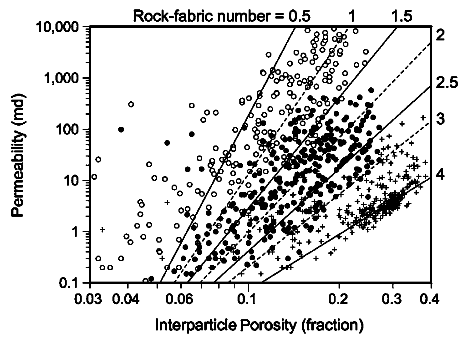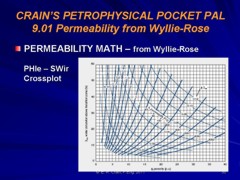|
 Permeability from the
LUCIA Method
Permeability from the
LUCIA Method
This is one of the
newer permeability methods, designed especially for handling
varying pore geometry in carbonates. It was proposed by
Jennings and Lucia in "Predicting Permeability from Well
Logs in Carbonates", SPE 2003. It is based on a concept
called the Rock Fabric Number (RFN) based on the porosity -
water saturation relationship in carbonates. Thc Wyllie-Rose
method handles the pore geometry problem by using the
irreducible water saturation in the denominaror of their
equation. The RFN is more explicit.
The relationship between RFN with porosity and saturation,
and with permeability and porosity, are shown in the two
graphs below.


<== Higher water saturation for a given porosity gives higher RFN.
Lower permeability for a given porosity gives higher RFN..
 Rock
Fabric Number from Lucia Method
Rock
Fabric Number from Lucia Method
The Lucia
method relies on a measure of inter-grain porosity, often callled
connected porosity, excluding isolated, vuggy, or moldic porosity.
This often considered to be:
1: PHIg = PHIe - PHIsec
Rock Fabric Number (RFN) is derived from:
2: RFN = exp ((7.163 + 1.883 * ln(PHIg) +
ln(SWir) ) / (3.063 + 0.610 * ln(PHIg))
Where:
PHIg = inter-grain porosity (fractional)
PHIe = shale corrected porosity from density neutron logs (fractional_
PHIsec = secondary porosity index (SPI) (fractional)
Sw = water saturation (fractional)
RFN = rock fabric number (unitless)
SPL is often assumed to be PHIxdn minus PHIsc, where PHIxdn is shale
corrected density neutron crossplat porosity and PHIsc is shale
corrected sonic porosity. It may also be assumed to be a constant, a
constant
 Permeability from
Lucia Method
Permeability from
Lucia Method
3: PERMrfn = exp((27.56 - 12.08 * ln(RFN)) +
((8.671 - 3.603 * ln(RFN)) * ln(PHIg)))
Where:
PERMrfn = permeability (mD)
 COMMENTS:
COMMENTS:
You
can estimate RFN based on sample descriptions instead of calculating
it based on equations 1 and 2. Or use RFN as a calibrating parameter
to match core data.
 RECOMMENDED
PARAMETERS:
RECOMMENDED
PARAMETERS:
None required.
 NUMERICAL
EXAMPLE:
NUMERICAL
EXAMPLE:
SWir = Sw
= 0.20
PHIg = 0.20
RFN = exp((7.163 + 1.883 * ln(0.20) + ln(0.20) ) / (3.036 + 0.61 *
ln(0.20))) = 3.36
PERMrfn = exp((27.56 - 12.08 * ln(3.36)) + ((8.671 - 3.603 *
ln(3.36)) * ln(0.20))) = 400 mD
 META/LOG "PERM" Compare
Permeability Calculated from Various Methods
META/LOG "PERM" Compare
Permeability Calculated from Various Methods
Download this spreadsheet:
SPR-24 META/LOG PERMEABILITY CALCULATOR
Calculate and compare permeability derived from well
logs,
5 Methods.
|




